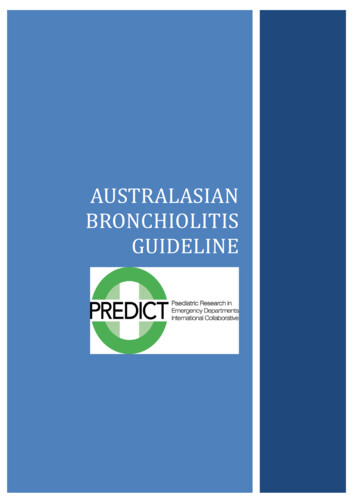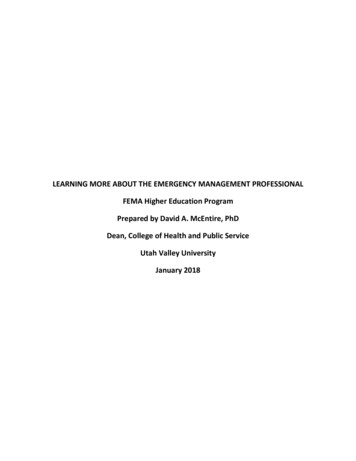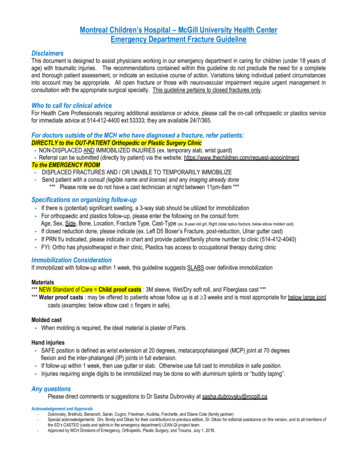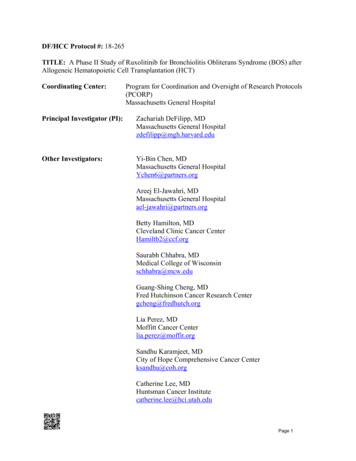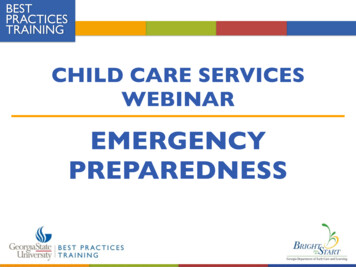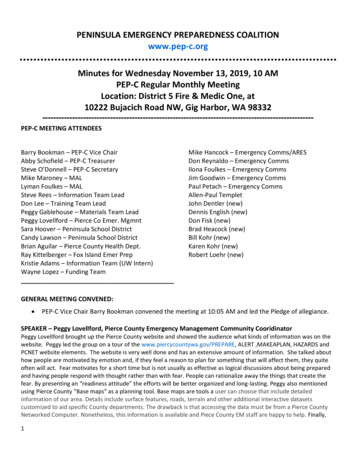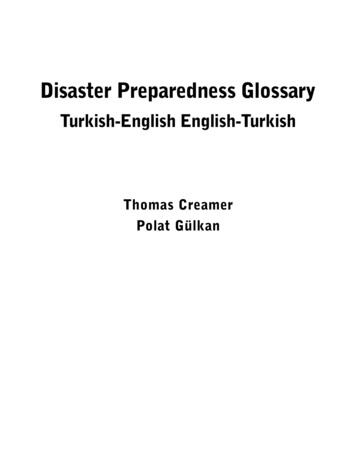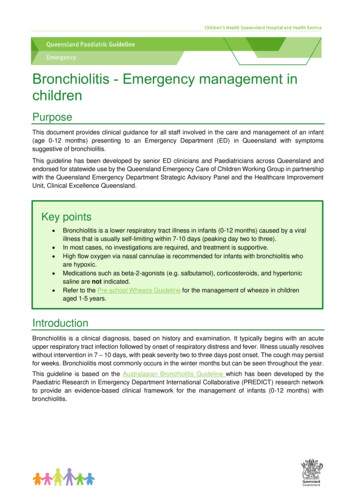
Transcription
Bronchiolitis - Emergency management inchildrenPurposeThis document provides clinical guidance for all staff involved in the care and management of an infant(age 0-12 months) presenting to an Emergency Department (ED) in Queensland with symptomssuggestive of bronchiolitis.This guideline has been developed by senior ED clinicians and Paediatricians across Queensland andendorsed for statewide use by the Queensland Emergency Care of Children Working Group in partnershipwith the Queensland Emergency Department Strategic Advisory Panel and the Healthcare ImprovementUnit, Clinical Excellence Queensland.Key points Bronchiolitis is a lower respiratory tract illness in infants (0-12 months) caused by a viralillness that is usually self-limiting within 7-10 days (peaking day two to three).In most cases, no investigations are required, and treatment is supportive.High flow oxygen via nasal cannulae is recommended for infants with bronchiolitis whoare hypoxic.Medications such as beta-2-agonists (e.g. salbutamol), corticosteroids, and hypertonicsaline are not indicated.Refer to the Pre-school Wheeze Guideline for the management of wheeze in childrenaged 1-5 years.IntroductionBronchiolitis is a clinical diagnosis, based on history and examination. It typically begins with an acuteupper respiratory tract infection followed by onset of respiratory distress and fever. Illness usually resolveswithout intervention in 7 – 10 days, with peak severity two to three days post onset. The cough may persistfor weeks. Bronchiolitis most commonly occurs in the winter months but can be seen throughout the year.This guideline is based on the Australasian Bronchiolitis Guideline which has been developed by thePaediatric Research in Emergency Department International Collaborative (PREDICT) research networkto provide an evidence-based clinical framework for the management of infants (0-12 months) withbronchiolitis.
AssessmentA diagnosis of bronchiolitis requires a history of an upper respiratory tract infection followed by onsetof respiratory distress with fever and at least one of the following: cough tachypnoearetractions diffuse crackles or wheeze on auscultationHistoryHistory should include specific information on: recent respiratory symptoms feeding including:o duration of feeds (feeding more difficult with more severe illness)o breast feeding underlying medical conditions including chronic lung disease, congenital heart disease and chronicneurological conditionschromosomal abnormalities including Trisomy 21indigenous statusprematuritypost-natal exposure to cigarette smokeExaminationAssessment of severity of acute /intermittentirritabilityIncreasing irritability and/orlethargy, fatigueRespiratory rateNormal - mild tachypnoeaIncreasedMarked increase ordecreaseUse of accessorymusclesNil to mild chest wallretractionModerate chest wallretractionsTracheal tugNasal flaringMarked chest wallretractionsMarked tracheal tugMarked nasal flaringOxygensaturations inroom airSpO2 92%SpO2 90-92%SpO2 90%May not be corrected by O2Apnoeic episodesNoneMay have brief apnoeaMay have increasinglyfrequent or prolongedapnoeaFeedingNormalMay have difficulty withfeeding or reducedfeedingReluctant or unable to feedCHQ-GDL-60012 – Bronchiolitis – Emergency management in children-2-
Consider seeking senior emergency/paediatric advice as per local practice for infant with moderatebronchiolitis.Seek senior emergency/paediatric advice as per local practice for a child with severe bronchiolitis.Risk factors for severe disease gestational age less than 37 weeks chronological age at presentation less than 10 weeks chronic lung disease congenital heart disease chronic neurological conditions Indigenous ethnicity failure to thrive Trisomy 21 post-natal exposure to cigarette smoke breast fed for less than 2 months Differential diagnosesWhilst bronchiolitis is the most common cause of respiratory distress in infants, less common diagnoses,or dual diagnoses must be considered in all children.Less common causes of respiratory distress in infantsRespiratory bacterial pneumonia, including pertussisaspiration of milk/formula or foreign bodytracheo/bronchomalaciacystic fibrosisOther congestive cardiac failuresepsisintrathoracic massallergic reactionCongenital cardiac diseaseALERT – Consider cardiac disease presenting with congestive cardiac failure in infants with noprecipitating viral illness, hypoxia out of proportion to severity of respiratory disease and/orpresence of abnormal or unequal peripheral pulses, cardiac murmur or hepatomegaly.Congenital cardiac diseases affect approximately 1% of infants with up to one third diagnosed at over 12weeks of age. Infants with congestive cardiac failure may present with respiratory distress and decreasedfeeding. Note that decompensation may be triggered by an intercurrent viral illness.CHQ-GDL-60012 – Bronchiolitis – Emergency management in children-3-
InvestigationsInvestigations are not routinely recommended. Respiratory viral PCR has no role in the management ofindividual patients (cohorting infants based on virological testing has not been shown to improveoutcomes). Chest X-rays (CXR) may lead to unnecessary antibiotic treatment.ALERT – Children aged less than three months with respiratory symptoms and fever 38⁰C mayhave a concurrent bacterial infection. Refer to Fever Guideline for guidance on investigationsand management.ManagementRefer to Appendix 1 for a summary of the emergency management for children presenting with symptomsof bronchiolitis.The primary treatment of bronchiolitis is supportive. This involves ensuring appropriate oxygenation andmaintenance of hydration.Seek urgent paediatric critical care advice (onsite or via Retrieval Services Queensland (RSQ)) forinfants with any of the following:o significant or recurrent apnoeaso persistent desaturations despite oxygeno severe disease who are failing to improve with initial treatmento moderate bronchiolitis with congenital heart disease or chronic lung diseaseOxygen and respiratory supportAdminister oxygen for children with saturations persistently below the target oxygen saturations (SpO2)as per local guidelines. Oxygen therapy is not recommended for infants with only brief episodes ofmild/moderate desaturation.There is no definitive evidence to determine the optimal target saturations. The Australasian BronchiolitisGuideline recommends target oxygen saturation (SpO2) of 92% but lower saturations may be tolerateddepending on institutional practice. A study on infants aged less than one year with bronchiolitis found thata target SpO2 90% was as safe and as clinically effective as 94%.1Consider seeking senior emergency/paediatric advice as per local practice if unsure of oxygenrequirement for a child with bronchiolitis.Low flow oxygenLow flow oxygen for infants with bronchiolitis by method of deliveryNasal prongsHudson maskMaximum flow rate of 2 L/minCommence at a minimum flow rate of 4 L/min toensure adequate delivery if oxygen requirement isgreater than 2 L/minHigh flow nasal cannula oxygen (HFNC) TherapyConsider HFNC therapy in infants with bronchiolitis who are hypoxic (SpO2 92%) with moderate to severework of breathing.CHQ-GDL-60012 – Bronchiolitis – Emergency management in children-4-
The positive airway pressure provided improves oxygenation and relieves work of breathing. HFNCtherapy applied early in the hospital admission in infants with bronchiolitis has been shown to bebeneficial.2 It may help avoid intubation but can also provide pre-oxygenation whilst preparation for inevitableintubation is underway.HFNC therapy is not recommend for infants without hypoxia.Follow local policies and procedures for nursing ratios and ward location. View CHQ Nasal High FlowTherapy Guideline.Continuous positive airways pressure (CPAP)Nasal CPAP therapy for infants with bronchiolitis may also be considered but is rarely used.MonitoringObservations should occur in line with local hospital guidelines and Early Warning Tools (EWTs).Continuous pulse oximetry is not routinely recommended for non-hypoxic infants or stable infants receivingoxygen.Hydration/nutrition small frequent feeds are recommended for infants with mild bronchiolitis nasal saline drops may be considered prior to the time of feedingsuctioning of the nares may assist feeding in infants with moderate distressALERT – Deep suctioning of the nasopharynx is not recommended as may cause oedema andirritation of the upper airway resulting in increased length of illness. NGT insertion is highly recommended for infants on HFNC. Advantages include:o gastric decompressiono ability to feed without interrupting HFNCo avoid potential for worsening of respiratory symptoms during feedingNG or IV hydration is recommended for infants with moderate -severe bronchiolitis who are feedinginadequately (less than 50% over 12 hours)if using IV route, isotonic IV fluids (Sodium Chloride 0.9% with glucose, or similar) arerecommendedthe volume of fluids required to maintain hydration is unclearTreatments NOT recommended beta 2 agonists (e.g. salbutamol) regardless of a personal/family history of atopycorticosteroidsadrenaline (nebulised, IM, or IV) except in peri-arrest or arrest situation hypertonic salineantibioticsantiviralsdeep nasal suctionchest physiotherapyCHQ-GDL-60012 – Bronchiolitis – Emergency management in children-5-
Escalation and advice outside of EDChild is critically unwell or rapidly deterioratingIncludes children with the following (as a guide) ongoing hypoxia despite oxygen therapy persistent apnoeic events moderate or severe respiratory distress congenital heart disease or chronic lung disease physiological triggers including:oooooRR 50HR 90 or 170sBP 65SpO2 93% in oxygen or 85% in airGCS 12Reason for contactWho to contactFor immediateonsite assistanceincluding airwaymanagementThe most senior resources available onsite at the time as per local practices.Paediatric criticalcare advice andassistanceOptions may include: paediatric critical care critical care anaesthetics paediatrics Senior Medical Officer (or similar)Onsite or via Retrieval Services Queensland (RSQ).If no onsite paediatric critical care service contact RSQ on 1300799 127: for access to paediatric critical care telephone advice to coordinate the retrieval of a critically unwell childRSQ (access via QH intranet)Notify early of child potentially requiring transfer.Consider early involvement of local paediatric/critical care service.In the event of retrieval, inform your local paediatric service.CHQ-GDL-60012 – Bronchiolitis – Emergency management in children-6-
Non-critical childMay include child with: moderate disease mild to moderate and risk factors for severe disease (see Assessment) any other significant clinical concernReason for contactWho to contactAdviceFollow local practices. Options:(includingmanagement,disposition orfollow-up) onsite/local paediatric service Queensland Children’s Hospital experts via Children's Advice andTransport Coordination Hub (CATCH) on 13 CATCH (13 22 82)(24-hour service) local and regional paediatric videoconference support via TelehealthEmergency Management Support Unit TEMSU (access via QH intranet)on 1800 11 44 14 (24-hour service)ReferralFirst point of call is the onsite/local paediatric serviceInter-hospital transfersDo I need a criticaltransfer? discuss with onsite/local paediatric serviceRequest a noncritical interhospital transfer contact onsite/local paediatric serviceNon-criticaltransfer forms view Queensland Paediatric Transport Triage Tool contact RSQ on 1300 799 127 for aeromedical transfers contact Children's Advice and Transport Coordination Hub (CATCH) on13 CATCH (13 22 82) for transfers to Queensland Children’s Hospital QH Inter-hospital transfer request form (access via QH intranet) aeromedical stepdown (access via QH intranet) commercial aeromedical transfers:oQantasoVirginoJetstarCHQ-GDL-60012 – Bronchiolitis – Emergency management in children-7-
When to consider discharge from EDThere is insufficient evidence to recommend absolute discharge criteria for infants attending the ED withbronchiolitis. Consider discharge for the following infants: able to maintain adequate oxygen saturations in room air feeding adequately parent/caregiver can safely manage the infant at home (consider time of day, parent/carercomprehension and compliance, access to transport and distance to the local hospital)Admission for a further period of observation may be considered for infants who meet the above criteriabut are early in their illness and have risk factors for more severe disease (refer to Assessment).On discharge, parent/caregiver should be provided with a Bronchiolitis factsheet and advised to seekmedical help prior to next appointment if worsening symptoms and inability to feed adequately.Follow-up with GP within two to three days or earlier if symptoms worsen.When to consider admissionThe decision to admit should be supported by clinical assessment, social and geographical factors andphase of illness.Facilities without a Short Stay Unit (SSU)Admission is required for infants who present with severe disease and likely for those with moderatedisease.Despite meeting the clinical discharge criteria, admission may be considered for infants: with risk factors for severe disease social issues including those that are geographically isolated from a hospital or have social issuesaffecting the ability to safely manage the child at homeFacilities with a Short Stay Unit (SSU)Consider admission to SSU for infants who are responding to treatment but require a brief period ofobservation or trial of feeding prior to discharge.When to consider admission to inpatient ward from SSUAdmission to an inpatient paediatric service is recommended for children who are failing to improve(persistent/recurring or worsening symptoms) after 12 hours of care.Related documentsGuidelines Australasian Bronchiolitis GuidelineFactsheet BronchiolitisCHQ-GDL-60012 – Bronchiolitis – Emergency management in children-8-
References1. Cunningham et al. Oxygen saturation targets in infants with bronchiolitis (BIDS): a double-blind, randomised, equivalence trial,Lancet 2015; 386: 1041–48.2. Franklin et al. A Randomized Trial of High-Flow Oxygen Therapy in Infants with Bronchiolitis. N Engl J Med. 2018 Mar22;378(12):1121-1131Guideline approvalDocument IDCHQ-GDL-60012Executive sponsorVersion no.2.0Approval date26/09/2019Executive Director Medical ServicesEffective date26/09/2019Author/custodianQueensland Emergency Care Children WorkingGroupReview date26/09/2022Supersedes1.0Applicable toQueensland Health medical and nursing staffDocument sourceInternal (QHEPS) ExternalAuthorisationExecutive Director Clinical Services (QCH)KeywordsBronchiolitis, lower respiratory tract, Paediatric, emergency, guideline,children, 60012Accreditation referencesNSQHS Standards (1-8): 1, 8DisclaimerThis guideline is intended as a guide and provided for information purposes only. The information has been prepared using amultidisciplinary approach with reference to the best information and evidence available at the time of preparation. No assurance isgiven that the information is entirely complete, current, or accurate in every respect. We recommend hospitals follow their usual practicefor endorsement locally including presenting it to their local Medicines Advisory Committee (or equivalent) prior to use.The guideline is not a substitute for clinical judgement, knowledge and expertise, or medical advice. Variation from the guideline, takinginto account individual circumstances may be appropriate.This guideline does not address all elements of standard practice and accepts that individual clinicians are responsible for: Providing care within the context of locally available resources, expertise, and scope of practice Supporting consumer rights and informed decision making in partnership with healthcare practitioners including the right todecline intervention or ongoing management Advising consumers of their choices in an environment that is culturally appropriate and which enables comfortable andconfidential discussion. This includes the use of interpreter services where necessary Ensuring informed consent is obtained prior to delivering care Meeting all legislative requirements and professional standards Applying standard precautions, and additional precautions as necessary, when delivering care Documenting all care in accordance with mandatory and local requirementsChildren’s Health Queensland disclaims, to the maximum extent permitted by law, all responsibility and all liability (including withoutlimitation, liability in negligence) for all expenses, losses, damages and costs incurred for any reason associated with the use of thisguideline, including the materials within or referred to throughout this document being in any way inaccurate, out of context, incompleteor unavailable. Children’s Health Queensland Hospital and Health Service 2019This work is licensed under a Creative Commons Attribution Non-Commercial V4.0 International licence. To view a copy of this licence,visit d.enYou are free to copy, communicate and adapt the work for non-commercial purposes, as long as you attribute Children’s HealthQueensland Hospital and Health Service and comply with the licence terms.For copyright permissions beyond the scope of this licence contact: Queensland Emergency Care of Children working group, Children’sHealth Queensland Hospital and Health Service, email QPEC@health.qld.gov.au.CHQ-GDL-60012 – Bronchiolitis – Emergency management in children-9-
Appendix 1Child 12 months* presents to ED with suspected bronchiolitisToxic features?YesNoManage as per Sepsis GuidelineConsider differential or dual diagnoses (Box A#)Aged 3months?YesNoBronchiolitis diagnosis (Box B#)Manage as per Fever Guideline for infants withfever⁰C and: age 28 days age 29 days - 3 months with atypicalrespiratory symptomsAssess severity (Box C#)MildModerate Small frequent feeds Consider nasal saline drops prior tofeedingResponding totreatment?No Nasal saline drops /- suctioning Oxygen /- HFNC to maintainSpO2 Consider fluids via NG(if intake less than 50% for 12 hours)Severe HFNC therapy Oxygen via HFNC to maintainSpO2 Fluids via NG or IVResponding totreatment?YesYesResponding totreatment?YesNoIdentify risk factors for severe disease: gestational age 37 weeks chronological age 10 weeks chronic lung disease congenital heart disease chronic neurological conditions Indigenous ethnicity failure to thrive Trisomy 21 post-natal exposure to cigarettesmoke breast fed for 2 months NoFluids IVFBC, U&E, VBGBlood cultureConsider:- antibiotics IV- CXR- critical care- intubationRisk factor/spresent?Responding totreatment?NoYesYesConsider dischargewith adviceConsider referral toinpatient serviceRefer to inpatientserviceNoRefer to PaediatricCritical Care*Refer to the Pre-school wheeze guideline for children aged 1-5 years# See next page for Box A, B and CConsider seeking senioremergency/paediatric adviceas per local practicesSeek senior emergency/paediatricadvice as per local practices. Considercontacting paediatric critical careCHQ-GDL-60012 – Bronchiolitis – Emergency management in children- 10 -Seek urgent paediatric critical care advice(onsite or via Retrieval ServicesQueensland (RSQ) on 1300 799 127)CHQ-GDL-60012-Appendix 1 V2.0
Appendix 1BOX A: Less common causes of respiratory distress in infantsRespiratoryOther bacterial pneumonia, including pertussis aspiration of milk/formula or foreign body tracheo/bronchomalacia cystic fibrosis congestive cardiac failuresepsisintrathoracic massallergic reactionConsider concurrent or alternative diagnosis of serious bacterial illness in child with high fevers.ALERT – Consider cardiac disease in infants with the following: no precipitating viral illness hypoxia out of proportion to severity of respiratory disease /- abnormal or unequal peripheral pulses, cardiac murmur or hepatomegalyKeep in mind decompensation can be triggered by an intercurrent illness.BOX B: Bronchiolitis diagnosisRequires a history of an upper respiratory tract infection followed by onset of respiratory distress withfever and 1 of the following: coughtachypnoea retractionsdiffuse crackles or wheeze on auscultationBOX C: Assessment of severity of acute /intermittentirritabilityIncreasing irritability and/orlethargy, fatigueRespiratory rateNormal - mildtachypnoeaIncreasedMarked increase ordecreaseUse of accessorymusclesNil to mild chest wallretractionModerate chest wallretractionsTracheal tugNasal flaringMarked chest wallretractionsMarked tracheal tugMarked nasal flaringOxygen saturationsin room airSpO2 92%SpO2 90-92%SpO2 90%May not be corrected by O2Apnoeic episodesNoneMay have brief apnoeaMay have increasinglyfrequent or prolongedapnoeaFeedingNormalMay have difficulty withfeeding or reducedfeedingReluctant or unable to feedCHQ-GDL-60012 – Bronchiolitis – Emergency management in children- 11 -
Follow local policies and procedures for nursing ratios and ward location. View CHQ Nasal High Flow Therapy Guideline. Continuous positive airways pressure (CPAP) Nasal CPAP therapy for infants with bronchiolitis may also be considered but is rarely used. Monitoring
